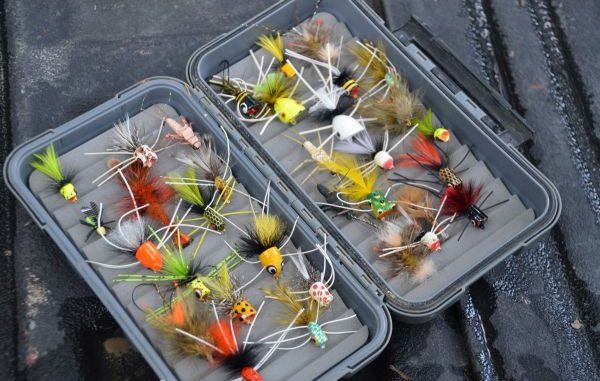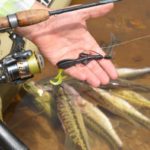
Float-fishing on small rivers is a minimalist sport, but some equipment is needed and other stuff is nice to have.
By the definition of floating, a boat of some type is needed. Not often seen anymore are the flat-bottomed wooden and aluminum boats in the days of yore.
Rather, kayaks dominate today, although float-fishing from a canoe is certainly possible.
Jesh Smith calls kayaks the ideal craft because they are maneuverable enough to get around logs. But he offered one piece of advice in choosing a kayak.
“Pick a kayak with a flat bottom,” Smith explained. “It allows you to scoot over logs. A keel on a kayak hangs up on logs. A kayak with a keel tracks well, but just isn’t as maneuverable.”
For creek fishing, Smith’s kayak is simply equipped. He has no rod holders, and the ubiquitous milk crate found on most kayaks to hold equipment is absent.
“The more stuff you have, the more you have to fall overboard or cause to turn the kayak over when it hangs up,” he said.
Smith is particular about his paddle, using a full carbon fiber model.
“You don’t get these at Walmart,” he quipped. “Go to a kayak store. Their 24- to 26-ounce weight is an advantage.
“An aluminum-and-plastic paddle will weigh about 40 ounces. When you paddle 10 to 12 miles in a day, it makes a difference.”
A life jacket with chest pockets to hold lures and tackle is incredibly handy. The law requires the presence of a life jacket onboard, even though the water is seldom over waist deep.
Rather than having it and the fishing tackle underfoot in the small boat, only to have to struggle to retrieve them if the kayak flips, Smith simply wears the life jacket as a tackle box.
In one pouch, where he could quickly locate it, Smith stashed a tool he used a lot during this trip — a stainless steel hemostat that made simple work of unhooking his fish from the small poppers.
Anyone who has floated Louisiana’s clear-water streams will bear witness to one of the activity’s great plagues: sand, gravel and sticks that invariably work their way into sneakers or, even worse, sandals.
Smith has solved that problem by wearing Vibram FiveFingers Sports Shoes. They look odd, with individual sleeves for each toe, but they keep the sand out and offer the additional benefit of preventing slipping on slick surfaces.
One place Jesh Smith doesn’t compromise is in the quality of his fishing tackle. Spinning equipment includes a 5-foot-long ultralight St. Croix Avid rod and a Shimano Stella reel, a rig that will set you back $750.
The reel is spooled with 6-pound-test Suffix braided line. His favorite lure for the rig is a 4-inch Zoom Baby Brush Hog. His favorite color is a custom-poured black neon he orders online.
For soft plastics, Smith maintains that darker colors are better.
The lure is impaled on a 1/8-ounce Gamakatsu hook that has a bullet weight molded onto the shaft of the hook.
Smith admits that 1/8-ounce buzz baits are very effective, but they are his least-favorite lure because he likes baits that offer a challenge.
“They are good beginner baits,” he said of buzz baits. “They seldom get hung up.”
His favorite brand is Boogerman, but effective buzz baits can be purchased at any big-box discount store. Color doesn’t matter to him because he thinks these lures simply trigger reactive strikes.
For fly-fishing, Smith recommends 3- to 5-weight rods. His personal rod is a 7-foot, 2-inch, 5-weight split-bamboo beauty built by Bill Critchfield of Cane Classics.
While he is proud of the rod, which costs about $1,000, he admitted standard store-bought rods will work just fine.
His reel is an Orvis milled bar stock CFO III.
His choice of fly line is weight-forward, floating Scientific Angler tipped with a 8-pound-test monofilament leader stretching 4 to 5 feet.
Lures for the fly rod, which he inevitably calls “flies,” are actually size 6 or 8 floating poppers. Black-and-yellow is his go-to color, although chartreuse-and-white also works well.
He experiments very little with color in his poppers.

